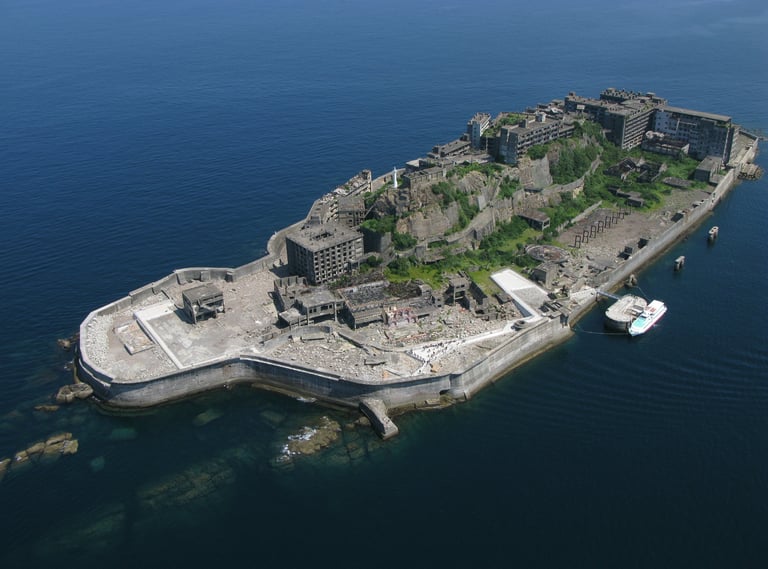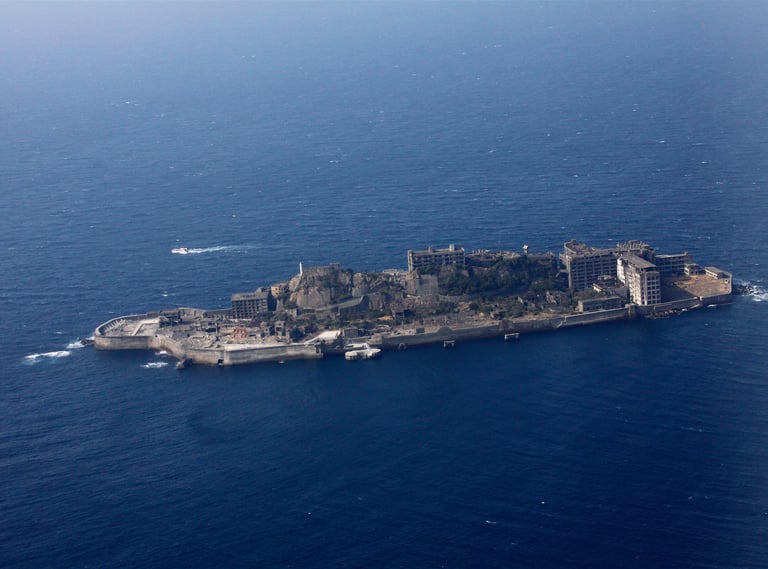Gunkanjima (Hashima Island): The Forgotten Fortress of the Sea
11/3/20253 min read




⚙️ Birth of a Coal Island
Gunkanjima, officially known as Hashima Island, is a small island located about 18 kilometers southwest of Nagasaki City. Originally, it was just a rocky outcrop barely 1.2 kilometers in circumference. Everything changed in the Meiji era when coal was discovered, and in 1890 Mitsubishi purchased the island to begin full-scale mining operations.
As coal extraction expanded, more land was reclaimed to make room for workers and facilities. Over time, the island’s shape came to resemble a battleship floating on the sea — hence the nickname “Gunkanjima,” meaning “Battleship Island.”
🏙️ The Most Densely Populated Island in the World
At its peak in the 1960s, about 5,300 people lived on this tiny 6.3-hectare island — one of the highest population densities ever recorded, nine times higher than that of Tokyo at the time.
Despite its small size, the island had everything a city needed: schools, a hospital, a shrine, a movie theater, barber shops, and even a pachinko parlor. It was like a self-contained city floating on the ocean. In 1916, Japan’s first reinforced concrete apartment building was constructed here, marking an important milestone in the nation’s architectural history.
🪨 Life on the Island
Life on Gunkanjima was close-knit and full of character. Because space was limited, everyone depended on each other, forming a strong sense of community. People often said it felt like one big family.
Residents fondly recall how “the wind was so strong that laundry often blew away — but no one minded if someone else’s clothes got mixed in.” Children played baseball on rooftops, and whenever a ball fell into the sea, they would dive in to retrieve it. Despite the harsh working conditions in the mines, the island was full of energy and laughter.
🌑 Closure and the Island Where Time Stopped
In 1974, as Japan shifted from coal to oil during the energy revolution, Hashima’s coal mine was closed. Within a single day, all residents left the island, and Gunkanjima became completely uninhabited.
Furniture, pianos, textbooks, and calendars were left exactly as they were, creating an eerie atmosphere — as if time itself had frozen. For more than 40 years, entry to the island was prohibited, and the once-bustling buildings slowly crumbled under the force of wind and waves.
🌏 World Heritage Recognition and Rediscovery
In 2015, Gunkanjima was registered as part of the “Sites of Japan’s Meiji Industrial Revolution” on the UNESCO World Heritage list. Today, it stands as a powerful symbol of human endurance and industrial history, attracting visitors from all over the world.
Landing tours allow people to walk among the remains of old housing blocks and mining facilities. Many describe the experience as “like stepping into a movie set.” In fact, the island’s haunting beauty was featured in films such as “007: Skyfall,” bringing global attention to its ghostly charm.
💡 Fascinating Stories from the Island
No need for keys: Everyone knew each other, and theft was unheard of, so most homes never used locks.
Rooftop gardens: Because there was no soil, residents carried dirt up to the rooftops to grow vegetables like tomatoes and green onions.
Bright nights: The lights from the 24-hour mining operation and neon signs kept the island glowing even at night, as bright as a city.
🕯️ In the End
Gunkanjima is more than a ruin — it is a place where thousands once lived, worked, and dreamed. It represents both the pride of Japan’s industrial rise and the fleeting nature of progress.
Many visitors say they can still “feel the presence of people within the silence.” Perhaps that lingering human warmth, preserved within the crumbling concrete walls, is what continues to draw people to this mysterious island today.
